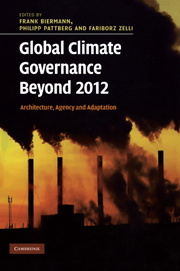Book contents
- Frontmatter
- Contents
- List of contributors
- Preface
- List of abbreviations
- 1 Global climate governance beyond 2012
- Part I Architecture
- 2 The architecture of global climate governance
- 3 The consequences of a fragmented climate governance architecture
- 4 Environmental effectiveness and economic consequences of fragmented versus universal regimes
- 5 Developing the international carbon market beyond 2012
- 6 The overlap between the UN climate regime and the World Trade Organization
- 7 An architecture for long-term climate change
- 8 Shaping the architecture of future climate governance
- Part II Agency
- Part III Adaptation
- Index
- References
4 - Environmental effectiveness and economic consequences of fragmented versus universal regimes
what can we learn from model studies?
Published online by Cambridge University Press: 05 July 2014
- Frontmatter
- Contents
- List of contributors
- Preface
- List of abbreviations
- 1 Global climate governance beyond 2012
- Part I Architecture
- 2 The architecture of global climate governance
- 3 The consequences of a fragmented climate governance architecture
- 4 Environmental effectiveness and economic consequences of fragmented versus universal regimes
- 5 Developing the international carbon market beyond 2012
- 6 The overlap between the UN climate regime and the World Trade Organization
- 7 An architecture for long-term climate change
- 8 Shaping the architecture of future climate governance
- Part II Agency
- Part III Adaptation
- Index
- References
Summary
Introduction
The thirteenth conference of the parties of the climate convention had launched a negotiation process to craft a new international climate change agreement by the end of 2009. This agreement would need to stipulate emission reduction commitments, specify essential actions to adapt to the impacts of climate change and mobilize the necessary funding and technological innovation. Given these enormous challenges, the structure and design of a future climate agreement are still unclear. Besides the negotiations within the UN climate regime, major greenhouse gas emitting countries are also leading ad hoc debates in other forums, for example in the context of the Group of Eight and the Asia–Pacific Partnership on Clean Development and Climate. Depending on the course of these processes, a new climate governance regime could develop in different directions; it could end somewhere between a universal, inclusive governance architecture and a strongly fragmented, heterogeneous governance architecture (Biermann et al., this volume, Chapter 2).
In recent years, numerous universal and fragmented climate regimes have been proposed (for an overview, see Bodansky 2004; Blok et al. 2005; Philibert 2005; IPCC 2007: 770–773). Many of these regimes are quantitatively or qualitatively assessed, but no attempt has yet been made to compare the costs estimates of these studies for specific regions under different regimes. Nevertheless, the available material allows us to make an assessment of the regional costs of several universal and fragmented regimes, based on different models. This chapter presents a literature review concerning the economic effectiveness of a number of possible universal and fragmented regimes. We use only studies that quantitatively assess both emission reductions and costs. From a quantitative perspective, this chapter tries to answer the appraisal question of the ‘architecture’ domain of this book, namely whether a universal or a fragmented regime will be more effective to reduce greenhouse gas emissions.
- Type
- Chapter
- Information
- Global Climate Governance Beyond 2012Architecture, Agency and Adaptation, pp. 35 - 59Publisher: Cambridge University PressPrint publication year: 2010
References
- 1
- Cited by



